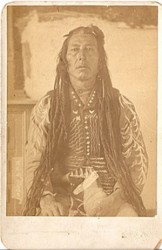Article Origin
Volume
Issue
Year
One 1885 historic re-enactment this summer, stirred up some controversy as organizers of the ‘Siege of Fort Battleford’ re-enactment at North Battleford, faced some backlash from a local First Nations man over a term used to promote the event.
Poundmaker band member, Tyrone Tootoosis, told media outlets that he did not agree with the use of the word ‘siege’ in referring to the August 14 re-enactment.
In 1885, after news broke out there was an Indian attack at Duck Lake, Chief Poundmaker travelled to Fort Battleford to ask for rations and supplies from the Indian Agent and to assure him that the band intended to remain peaceful. Approximately 500 people residing at Fort Battleford misinterpreted the approaching band as another impending Indian attack and went into hiding inside the Northwest Mounted Police building.
Mark Calette, Manager of Historic Sites for Parks Canada, said Fort Battleford has been delivering the program since 2007 and they have just recently started hearing complaints from local First Nations about the re-enactment.
“It’s not really a re-enactment persay, it’s more animation,” he explained.
“You go to different stations at the site and they just give little snippets of what people inside the fort were feeling during that period of time. … Probably the big issue for Tyrone (that) would spark most of his concern was the title of it.” Calette said and maintained that once First Nations people attend the event, they have no further concerns.
However, Tootoosis said the way the event is carried out perpetuates a negative view of First Nations people.
“There was no siege,” Tootoosis said in a Sage interview. “They didn’t attack it, they didn’t attack the fort. And the leaders at the time went there to reassure they weren’t going to join the rebellion and second of all to ask for rations. Because they had just come through a really tough winter, the buffalo were gone,” Tootoosis added. “They were killed off by government policy.”
He said calling the event a ‘Siege’ re-enactment continues to keep alive fear, a divide between the First Nations and mainstream communities.
“And that doesn’t necessarily reflect the trust relationship that should have been there after the treaty promises of 1876,” he said.
“There are still a lot of people out there in the Battlefords, that colonial mindset is still alive and well. There are people there who say ‘well there was a siege’. Look up the word siege, that’s what I would challenge them to do.”
Tootoosis said he wants to see Fort Battleford and Parks Canada take responsibility for how the event was portrayed and get the oral historical accounts from local First Nations Elders. He said in all fairness, Fort Battleford’s manager, Scott Whiting, did invite him to discuss how future re-enactments can be done differently.
“I think there would have to be a collaborative effort on the part of the people from the surrounding area. First Nations and Parks Canada so that it does show that the people, the 500 white people in the fort at that time were scared… scared out of their wits,” Tootoosis said. “At the same time, our perspective has to be told as well. Our people had no food. They were frustrated, the government had not lived up to its (treaty) promises.”
University of Saskatchewan professor, historian, and author, Bill Waiser told Sage that it is a mistake to call the event a siege because it was only a siege in the minds of those at the fort.
“People of Battleford, they had heard what had happened at Duck Lake. They were confused, they were alarmed, they were frightened and they had taken refuge within the stockade. And they really didn’t know what was going on around them,” Waiser said.
“And I think on the other side, the Cree were just as confused and concerned. They too had heard what had happened at Duck Lake. And they had gone to Battleford to declare their allegience to the Queen and ask for small rations… there was fear and confusion on both sides.”
Waiser said there is a need for both sides to come to a common understanding of that history. Furthermore, he agreed that the First Nations perspective of historical events is only just beginning to be accepted by mainstream.
“We’ve made good progress in the last 20/30 years,” Waiser said. “The book ‘Loyal Til Death’ is an example of the progress we’ve made where Blair and I – he a Cree person, me a moniyas (Cree for ‘white person) – worked together on this project and worked successfully together.”
However, Waiser said, society is still trying to understand what happened in 1885.
“There’s still more work to be done. Even though it’s been 125 years ago,” he added.
Meanwhile, Calette said he is glad that Tootoosis brought forward the issue, because it helps Parks Canada to improve their programs.
“We certainly don’t want to do anything that would create any kind of misunderstandings or cause it to be viewed in a way that seems one-sided,” he said, adding Parks Canada will look at reviewing the appropriateness of the name and change it if they find it’s not.
“Another thing that would be wonderful in the future is if the First Nations were able to kind of talk about what they were doing during that time and have the visitors get that directly from them,” he said.
Calette added that Parks Canada is open to hearing peoples’ concerns and they want to work with all parties to improve on current programs at the historic sites.
Parks Canada oversees Saskatchewan’s historic sites including Fort Battleford, Fort Walsh, the Batoche National Historic Site, Grasslands National Park, and Motherwell Homestead.
- 3075 views

